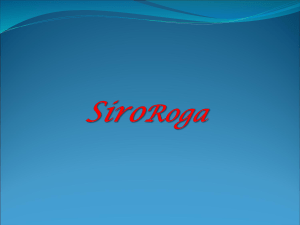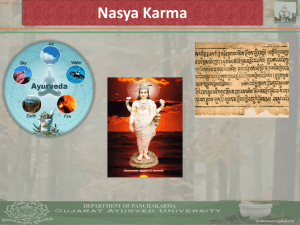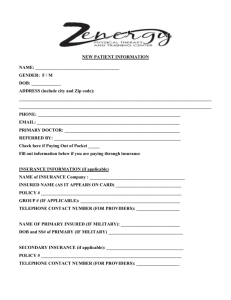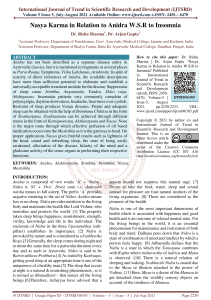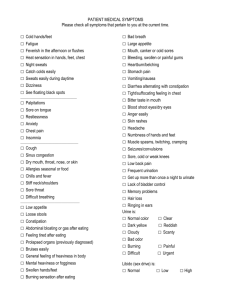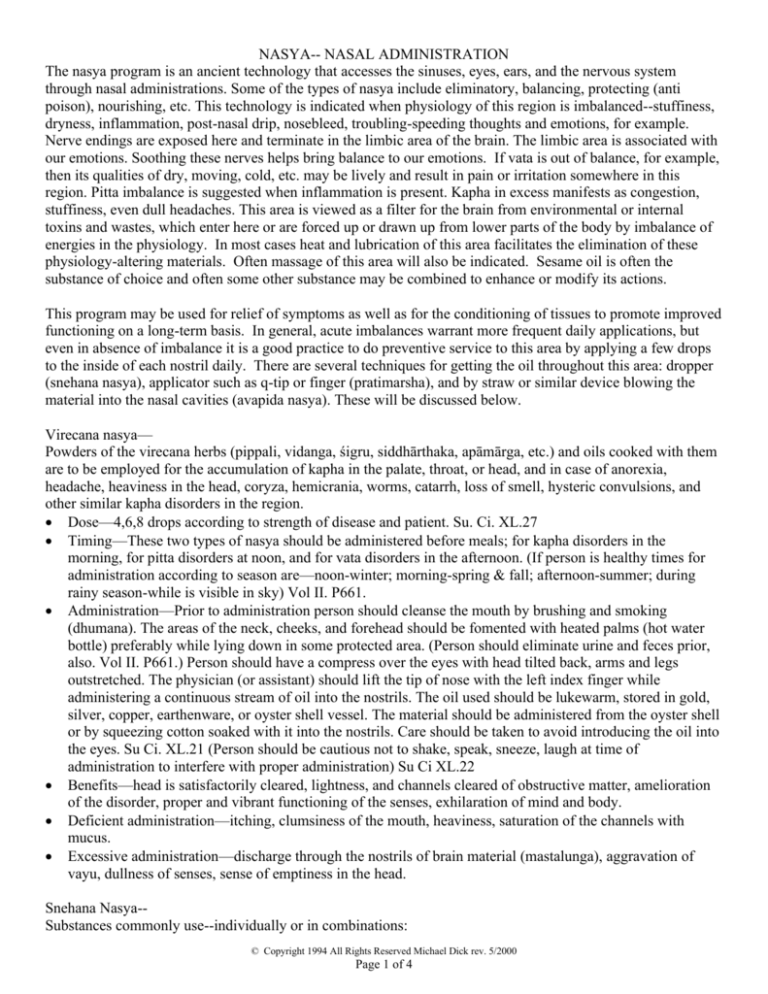
NASYA-- NASAL ADMINISTRATION
The nasya program is an ancient technology that accesses the sinuses, eyes, ears, and the nervous system
through nasal administrations. Some of the types of nasya include eliminatory, balancing, protecting (anti
poison), nourishing, etc. This technology is indicated when physiology of this region is imbalanced--stuffiness,
dryness, inflammation, post-nasal drip, nosebleed, troubling-speeding thoughts and emotions, for example.
Nerve endings are exposed here and terminate in the limbic area of the brain. The limbic area is associated with
our emotions. Soothing these nerves helps bring balance to our emotions. If vata is out of balance, for example,
then its qualities of dry, moving, cold, etc. may be lively and result in pain or irritation somewhere in this
region. Pitta imbalance is suggested when inflammation is present. Kapha in excess manifests as congestion,
stuffiness, even dull headaches. This area is viewed as a filter for the brain from environmental or internal
toxins and wastes, which enter here or are forced up or drawn up from lower parts of the body by imbalance of
energies in the physiology. In most cases heat and lubrication of this area facilitates the elimination of these
physiology-altering materials. Often massage of this area will also be indicated. Sesame oil is often the
substance of choice and often some other substance may be combined to enhance or modify its actions.
This program may be used for relief of symptoms as well as for the conditioning of tissues to promote improved
functioning on a long-term basis. In general, acute imbalances warrant more frequent daily applications, but
even in absence of imbalance it is a good practice to do preventive service to this area by applying a few drops
to the inside of each nostril daily. There are several techniques for getting the oil throughout this area: dropper
(snehana nasya), applicator such as q-tip or finger (pratimarsha), and by straw or similar device blowing the
material into the nasal cavities (avapida nasya). These will be discussed below.
Virecana nasya—
Powders of the virecana herbs (pippali, vidanga, Âigru, siddh±rthaka, ap±m±rga, etc.) and oils cooked with them
are to be employed for the accumulation of kapha in the palate, throat, or head, and in case of anorexia,
headache, heaviness in the head, coryza, hemicrania, worms, catarrh, loss of smell, hysteric convulsions, and
other similar kapha disorders in the region.
Dose—4,6,8 drops according to strength of disease and patient. Su. Ci. XL.27
Timing—These two types of nasya should be administered before meals; for kapha disorders in the
morning, for pitta disorders at noon, and for vata disorders in the afternoon. (If person is healthy times for
administration according to season are—noon-winter; morning-spring & fall; afternoon-summer; during
rainy season-while is visible in sky) Vol II. P661.
Administration—Prior to administration person should cleanse the mouth by brushing and smoking
(dhumana). The areas of the neck, cheeks, and forehead should be fomented with heated palms (hot water
bottle) preferably while lying down in some protected area. (Person should eliminate urine and feces prior,
also. Vol II. P661.) Person should have a compress over the eyes with head tilted back, arms and legs
outstretched. The physician (or assistant) should lift the tip of nose with the left index finger while
administering a continuous stream of oil into the nostrils. The oil used should be lukewarm, stored in gold,
silver, copper, earthenware, or oyster shell vessel. The material should be administered from the oyster shell
or by squeezing cotton soaked with it into the nostrils. Care should be taken to avoid introducing the oil into
the eyes. Su Ci. XL.21 (Person should be cautious not to shake, speak, sneeze, laugh at time of
administration to interfere with proper administration) Su Ci XL.22
Benefits—head is satisfactorily cleared, lightness, and channels cleared of obstructive matter, amelioration
of the disorder, proper and vibrant functioning of the senses, exhilaration of mind and body.
Deficient administration—itching, clumsiness of the mouth, heaviness, saturation of the channels with
mucus.
Excessive administration—discharge through the nostrils of brain material (mastalunga), aggravation of
vayu, dullness of senses, sense of emptiness in the head.
Snehana Nasya-Substances commonly use--individually or in combinations:
© Copyright 1994 All Rights Reserved Michael Dick rev. 5/2000
Page 1 of 4
Sesame Oil
Camphor Oil
Eucalyptus Oil
Ghee
PN1
PN2} I-800-ALL VEDA
PN3
BRAHMI GHEE
SIDDHA SOMA OIL} (505) 291-9698
SUPER NASYA
Dose—Sushruta describes uncting nasya as having three doses: 8 drops (minimal), 32 drops (intermediate), 64
drops (highest). Proper dose varies according to the strength of the patient and of the disease under treatment.
An oily snuff should never be swallowed. An oily nasya should be taken so as to flow along the girths of the
nostrils and immediately spit out, without retaining it in the mouth for moment as it may aggravate the local
kapha. Local fomentation of the cheeks, neck etc. should follow. Su. Ci. XL.23-25
Administration—The neck, cheeks, etc. should be fomented (prior to and after receiving). (A hot water
bottle filed with hot water may be used for this.) While lying on the back with head back (over the edge of a
bed, for example) administer the desired number of drops of oil by dropper (or finger) into the nostrils.
Then, several times, person should "sniff" the oil up while gently blocking and releasing the nostril openings
with index and thumb. Meals following in due time should be devoid of phlegmatic substances. Further, one
should avoid washing the head immediately thereafter, exposure to dust, smoke, intoxicants, oily
substances, indulgence in emotional outburst, and excessive traveling, etc. Su Ci XL.25
Benefits—lightness of head, sound and beneficial sleep, alertness, alleviation of the imbalance, cheerfulness
of mind and clarity and vitality of functioning to the sense organs.
Signs of excessive nasya—salivation, heaviness in the head, dullness of sense organs. Su. Ci. XL.26
Signs of deficient application—functional derangement of the senses, dryness and lack of amelioration of
the disorder. To remedy re-apply the snehana nasya. Su. Ci XL.26
Pratimarsha: timing—Su Ci XL.34-35
1. Immediately upon arising from sleep—removes wastes and imparts cheerful state of mind
2. After cleaning teeth—imparts sweet aroma to mouth and makes the teeth firm
3. Prior to leaving house—protects against smoke and dust in the air
4. Following fatiguing exercise—removes the sense of fatigue
5. After sex—removes the sense of fatigue
6. After a long journey—removes the sense of fatigue
7. After defecation—tends to remove dullness or heaviness of vision
8. After urination—tends to remove dullness of heaviness of vision
9. After gargling—invigorates the eyesight
10. After collyrium—invigorates the eyesight
11. On empty stomach—cleanses the internal channels and imparts lightness to the body
12. After vomiting—cleanses the mucus deposits and brings appetite for food
13. After napping—tends to remove the sense of heaviness and drowsiness and cleanses the nasal passages
14. In the evening—promotes good sleep and proper awakening
The dose—that amount of sneha which being lightly sniffed in that reaches the cavity of the mouth is
deemed as appropriate.
The benefits--improves functioning to the supra-clavicular area generally, freshens and clarifies the senses,
imparts sweet aroma to the mouth, strength to the teeth, jaw bones, head, neck, the trika marma, arms and
chest, and guards against baldness, vyanga, premature greying, and premature lines and wrinkles. Su Ci XL
36-37
Avapida Nasya—
Should be administered to person bitten by snake, or lying comatose or unconscious while suffering from a head
disorder caused by accumulation of kapha.
Administration—by pasting to afflicted bite or / and by applying drops into the nostrils. In case of mental
disorders, parasitic infection, poisoning, the powder should be blown into the nostrils. In cases of rakta pitta
© Copyright 1994 All Rights Reserved Michael Dick rev. 7/29/05
Page 2 of 4
or debility administration of sugar, juice of sugar cane, milk, ghee, or meat broth may be done. Su. Ci.
XL.31
Contraindications—while fasting, having just eaten, acute catarrh or coryza, enciente woman, under
influence of intoxicants or oily, liquid substances, indigestion, treated by basti, anger, agitated state of mind,
excessive thirst, slow chemical poisoning, fatigued, grief, child, aged, suppression of urges, about to take
full bath. Also, nasya and smoking should be avoided during unseasonably overcast sky.
Defective administration—too much or too little, too hot or too cold, sudden or delayed application,
improper position of head or movement during administration, use preceding meals—leading to thirst,
eructations, etc. Su. Ci. Xl.32
INDICATIONS & CONTRAINDICATIONS FOR NASYA
The following are fit for nasya Ca. Si. II.22
Stiffness in head, teeth, carotid area
Obstruction in throat and jaw
Coryza
Uvulitis
Tonsillitis
Disorders of cornea, vision and eyelids
Vya¥ga
Upajhivik±
Migraine
Disorders of neck, shoulder, scapula, mouth nose,
ear, eye, cranium, and head
Facial paralysis
Apatantraka
Apatan±ka (convulsive disorders)
Goiter
Pain
Tingling sensation
Looseness of teeth
Streaks in eye
Tumor
Hoarseness of voice
Obstructed speech
Stammering and loss of speech
Other v±ta disorders located in the supraclavicular
area
In these head evacuation is regarded as the most important as from entering the head it eliminates pathogenic
impurity as an adherening stalk from the reed.
Nasya should be taken in season other than early rain, autumn, and during spring only in case of emergency and
with suitable protection. It should be taken in AM in summer, at noon in winter and rainy season when weather
is not cloudy. Ca. Si. II.23
The following are Contraindications for nasal administration (nasya):
Indigestion or full stomach—the impurity obstruct the upward carrying channels leading to cough,
vomiting, dyspnea and coryza
having previously taken uncting substance—may produce discharge from mouth and nose and lachrymal
discharge, defects of vision and head disorders
craving for alcohol or water--ditto
head bath or craving for bath—coryza may result
hunger—may vitiate v±ta
thirst—may increase thirst
exertion—may lead to feeling of more fatigue
intoxicated--ditto
unconsciousness / fainting--ditto
bodily injury with weapon—may increase the pain
depleted from sex—may cause pain in shoulder, eyes, chest
physical exercise or drinking--ditto
acute fever—heat circulating through eyes may cause defects of vision or increase the fever
© Copyright 1994 All Rights Reserved Michael Dick rev. 7/29/05
Page 3 of 4
grief--ditto
having undergone purgation—v±yu disturbs the senses *
or uncting enema—kapha may produce heaviness in head, itching and worms
pregnancy—may injure fetus: one-eyed, humped, crooked arm, hemiplegic, lame
acute coryza—may damage the channels
in unsuitable season and bad weather—may cause the defects of cold, fetid nostrils and head diseases.
Ca. Si. II.20-21 (See also Bhela Si. II.24)
© Copyright 1994 All Rights Reserved Michael Dick rev. 7/29/05
Page 4 of 4

